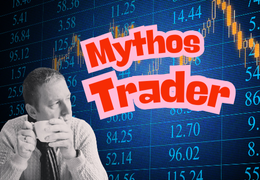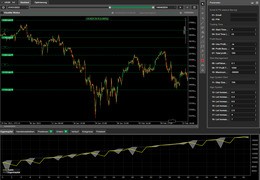Between reality and illusion If you want to know what trading really means—beyond luxury cars, piles of cash, and...
Risk management in trading: How to protect your capital
Why is risk management important?
Risk management helps traders limit their losses and maximize their profits. It protects capital from large losses and allows you to stay in the market for the long term. By using risk management techniques, traders can minimize the impact of negative market movements and implement their trading strategies more consistently.
A good risk management system also allows traders to minimize emotional decisions that often lead to irrational and harmful behavior. It creates a structure and a plan so traders know what to do before a situation occurs.
Basic concepts of risk management
-
Position sizing
Determining the optimal position size is crucial to controlling the risk of each trade. A commonly used rule is the 1-2% rule, where only 1-2% of available capital should be invested in a single trade.
-
Example : If a trader has an account with 10,000 euros, he should not risk more than 100 to 200 euros per trade.
Another method of determining position size is the Fixed Fractional Model, where a fixed percentage of capital is always risked. This helps keep the risk in proportion to the growing or shrinking account.
-
Stop-loss orders
A stop loss order is a predefined sell order that is executed when the price of an asset reaches a certain value. It protects traders from large losses by automatically closing a position as soon as the market moves against it.
-
Example : If a trader buys a stock at 50 euros and sets a stop loss at 45 euros, the position will automatically be sold when the price falls to 45 euros, limiting the loss to 5 euros per share.
However, stop-loss strategies can vary. Some traders use trailing stop orders, which adjust the stop-loss value depending on the price movement to lock in profits while the price moves in the desired direction.
-
Take Profit Orders
A take profit order is the counterpart of the stop loss order and is used to lock in profits. Once the price of an asset reaches a certain value, the position is automatically closed to realize the profit.
-
Example : If a trader buys a stock at 50 euros and sets a take profit at 60 euros, the position will be automatically sold when the price reaches 60 euros and the profit will be locked.
Take profit strategies help traders stay disciplined and avoid allowing greed to lead to holding positions longer than necessary.
-
Diversification
Diversification is a technique that involves spreading capital across different assets or markets to spread risk. By investing in different asset classes, traders can mitigate risk because losses in one area can be offset by gains in another.
-
Example : A trader could invest his capital in stocks, bonds, commodities and currencies instead of putting everything into a single stock.
Diversification can also occur within an asset class. For example, stocks from different industries or regions could be held in a portfolio to reduce the specific risk of individual sectors or countries.
Advanced risk management techniques
-
Hedging
Hedging is a strategy in which traders take positions that can offset losses in other positions. This can be done through the use of derivatives such as options and futures.
-
Example : A trader who has a long position in a stock might buy a put option to protect against a decline in the stock price.
Hedging can also be done by taking positions in correlated markets. For example, a trader investing in crude oil might take an offsetting position in a related asset such as oil stocks or energy ETFs.
-
Risk-reward ratio
The risk-reward ratio helps traders evaluate the potential risk of a trade relative to its potential reward. A commonly used ratio is 1:3, where the potential reward is at least three times the potential risk.
-
Example : If a trader is willing to risk 100 euros, the potential profit should be at least 300 euros.
A good risk-reward ratio ensures that traders remain profitable in the long term, even if not all trades are successful. It also encourages disciplined trading by setting clear goals.
-
Kelly criterion
The Kelly criterion is a mathematical formula that helps calculate the optimal position size to maximize capital in the long term. It is based on the analysis of the probability of winning and the risk-reward ratio.
-
Formula : Kelly % = W - [(1 - W) / R], where W is the probability of winning and R is the risk-reward ratio.
-
Example : If the probability of winning is 60% (0.6) and the risk-reward ratio is 1:2 (0.5), then: Kelly % = 0.6 - [(1 - 0.6) / 2] = 0.4 (40%).
The Kelly criterion can help dynamically adjust position size and optimize capital growth. However, it is important to note that it does not provide absolute guarantees and should only be used as part of a comprehensive risk management strategy.
Psychological risk management
Controlling your emotions is an essential part of risk management. Emotions like fear and greed can lead to irrational decisions. Here are some techniques to improve the psychological aspects of risk management:
-
Discipline : Strictly adhere to your trading plan and risk management rules.
-
Patience : Wait for the best trading opportunities and avoid impulsive trading.
-
Self-reflection : Keep a trading journal to document and analyze your trades and the emotions associated with them.
A trading journal can help you identify emotional patterns and make long-term improvements. Write down why you entered a trade, what rules you followed, and how you felt about it.
-
Mindfulness and meditation : These techniques can help calm the mind and improve emotional control. Regular practice can increase concentration and well-being.
The role of technology in risk management
Modern trading platforms offer a variety of tools and features that facilitate risk management. Automated trading systems, alert functions and detailed analytics can help traders optimize their strategies and minimize risk.
-
Automation : By using trading robots or automated strategies, trades can be executed based on predefined rules without having to make emotional decisions.
-
Backtesting : Backtesting tools allow traders to test their strategies against historical data to evaluate their effectiveness and risks.
Backtesting helps build confidence in a trading strategy and understand how it has performed under different market conditions. It is a valuable tool for identifying potential weaknesses and making adjustments.
-
Analysis tools : Many platforms offer analysis tools that combine technical and fundamental indicators to give traders comprehensive insight into market conditions.
Conclusion
Risk management is an essential part of trading and can make the difference between long-term success and failure. By applying basic and advanced risk management techniques, controlling one's emotions and using modern technology, traders can effectively protect their capital and optimize their trading strategies. By focusing on risk management, traders can ensure that they are well positioned even in volatile markets and when unexpected events occur.
Discussion stimulus
What risk management strategies do you use in your trading activities? Do you have specific techniques or tools that have helped you particularly? Share your experiences and tips in the comments and let's learn together!

















